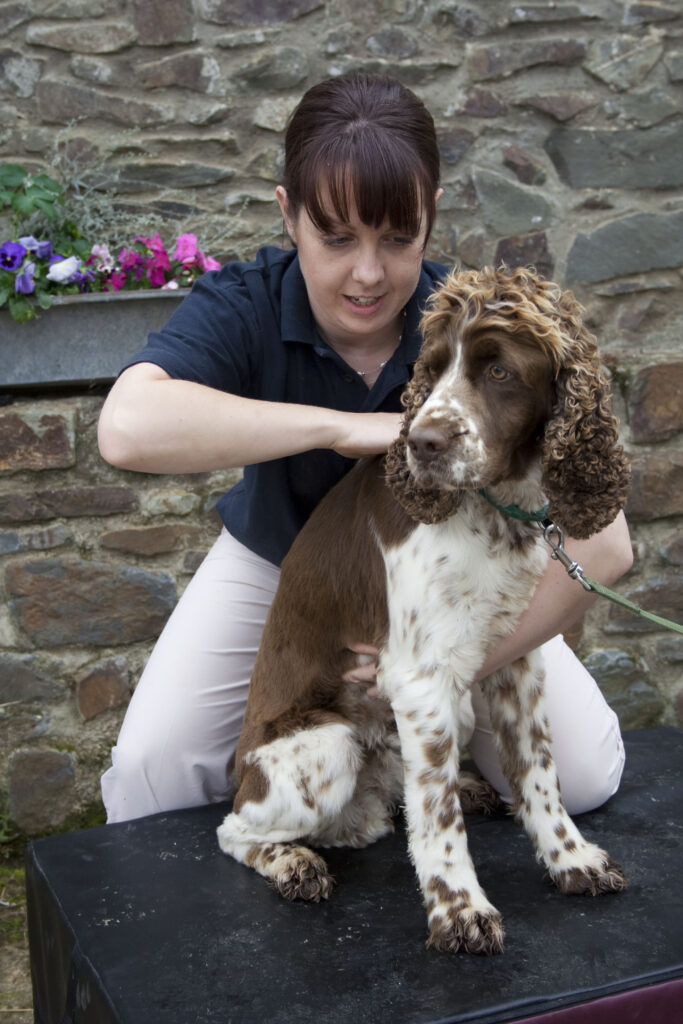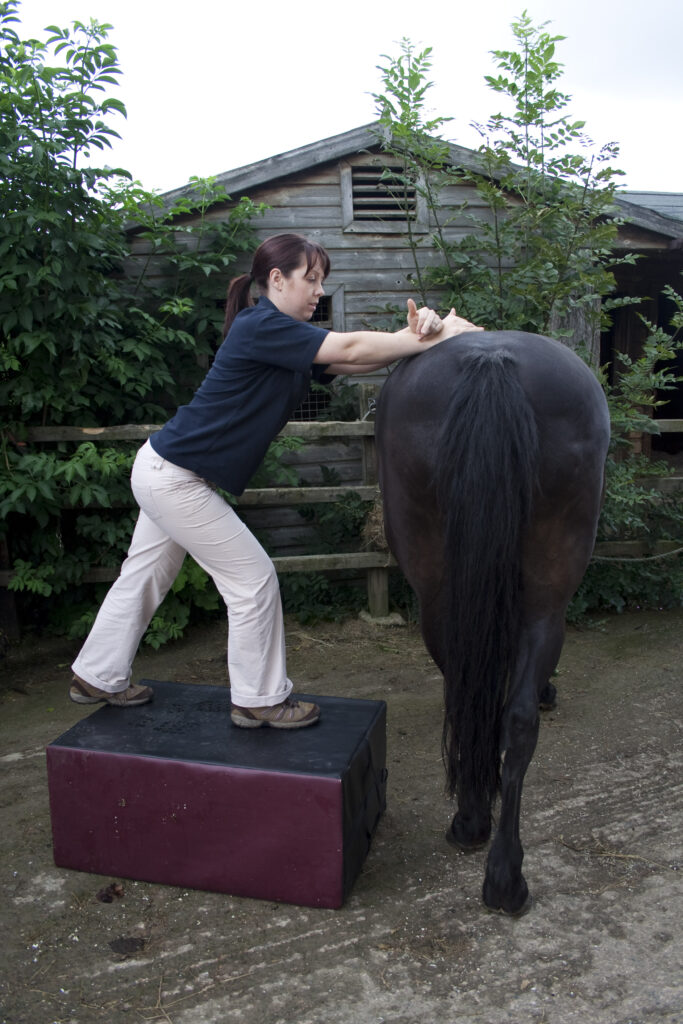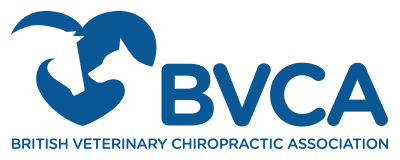Veterinary Chiropractic care is a manual therapy, which can be used for many health and performance problems.
It focuses on the biomechanical dysfunction of the spine and its effect on the entire nervous system throughout the body.
Veterinary Chiropractic treatment does not replace traditional veterinary medicine; however, it can provide additional means of diagnosis and treatment options for spinal problems as well as biomechanical related musculoskeletal disorders. Veterinary Chiropractic can often eliminate the source of acute or chronic pain syndromes.

Veterinary chiropractic treatment can be used for:
- Chronic musculoskeletal problems
- Acute problems such as tension or stiffness
- Prophylactic treatment to maintain fitness
- Maintain soundness in older animals
- Enhance performance ability of sport animals
- As a complementary treatment for chronic lameness such as bone spavin, navicular syndrome or tendon problems in the horse as well as arthrosis, spondylosis or tendon problems like cruciate ligament in the dog.
Signs and Symptoms
Any movement from a turn of the head to a twitch of a tail can be affected by both the mechanical and neurological effects of a spinal subluxation. If a subluxation exists, an animal loses normal flexibility of its spine, affecting performance and resulting in stiffness, muscular tension and pain.
Recognising problems in horses:
- Reduced performance
- Abnormal posture
- Snapping and pinning back its ears when being saddled
- Insubordination when being ridden
- The attempt to free itself by throwing its head back or up or by hollowing the back
- Swishing its tail and pinning back its ears
- Disobedience when jumping
- Difficulties with collected or lateral gaits
- Sensitivity to touch
Recognising problems in dogs:
- Reluctance to move
- Abnormal posture
- Disability to climb stairs or jump onto araised areas
- Signs of pain when performing certain movements or being lifted
- Disobedience when jumping
- Altered sitting position (so-called “puppy sitting”) or lying on one side only
Qualified animal chiropractors are trained to recognise and treat subluxations, however you can look for signs yourself:
Examining mobility
The animal should be able to move freely in all directions without tension.
Using a treat if necessary, ask the animal to turn its head and neck to the side so that it touches its flank with its nostrils. Less mobility one side compared to the other could indicate a problem in the cervical vertebrae.
Test the lateral movement of the spine by placing one hand on the spine and with the other pull the animals tail carefully towards you so that its back bends around your hand. Is one side stiffer than the other?
Place slight pressure on the back from above. The back should easily and evenly, spring and swing. It should not feel stiff and hard.
Feeling the muscles
Examine the animal´s main muscle groups for pain, tension and asymmetry. The muscles of a healthy animal should be symmetrical; feeling firmly elastic but not too hard or too soft. If you place the muscles under moderate pressure, the animal should not show signs of being in pain.
Feeling the spine
Feel the spine from the withers to the tail, paying attention to any elevations and protruding areas of bone. Compare the two sacral tubercles (the bony points of the pelvis which protrude from the croup on both sides of the spine) these should be level. Look for any protruding areas of bone in the neck.
Treatment

When a practitioner qualified in either chiropractic or veterinary medicine, professionally trained in animal chiropractic, identifies a subluxation, he or she aims to correct the misalignment of the spine and restore mobility to the facet joints.
Realignment is made via a quick, short thrust along the plane of the joint. This is called an adjustment. The adjustment is a very specific, high-speed, low-force manoeuvre that moves the affected joint beyond the normal physiological articular range of movement, without exceeding the boundaries of anatomical integrity. It is done by placing the hands directly on the affected vertebra (previously identified in the examination). Only subluxated vertebrae are adjusted.
Even though horses have a very large, thick muscle mass over the spine, the vertebral joints are flexible and relatively easy to manipulate with minimal force. If the correct technique is used the ligaments are not adversely affected.
Prevention
General advice
When selecting your animal for a particular discipline, you should always pay attention to it’s build. Many breeds have been selectively bred for years to achieve certain goals and are therefore suitable for particular disciplines such as dressage, jumping or western riding in the horse, or agility, hunting or gundog-work in the dog.
Massage encourages circulation and metabolism within the muscles, promoting the supply of nutrients and removal of toxins. Massage relaxes tense muscles enabling them to function better. It can also promote healing in muscular injuries by loosening muscle fiber adhesions and increasing the flow of fluid and toxins from the tissue.
It is practically impossible for a poorly shod horse or a horse with badly fitting shoes to have or maintain a spine that functions properly. Heels that are too high or underrun, toes as well as toenails in the dog that are too long or uneven hoof wall length can negatively affect the mobility and posture of the animal. For the limb and spinal joints to function properly, it is necessary for the animal to be correctly trimmed or shod.
Animals have an increasing tendency to subluxate and damage the spine if ligaments, tendons and muscles have not been developed to cope with the demands they are placed under. Interval training, suitable warm-up procedures and variety in training can help optimally condition sport animals.
Specifically for horses
Ensure that your saddle fits your horse. If a saddle fits correctly, no thick padded saddle cloth/numnah or additional pads are necessary. Check your saddle regularly to see whether the flocking is evenly worn, there is asymmetry of the panels or tree and that the saddle tree is intact. Any dampness under the saddle area after riding should be even in distribution. On the dog, make sure that your leashes fit the dog preferring broad and soft materials.
Many horses are forced into a desired frame with side-reins, martingales, draw-reins and other auxiliary reins. Used correctly, some of these aids can help in training; however, in the wrong hands they do the opposite. If a restriction in the spine already exists, these aids can make the problem even worse. Continual jerking and pulling on the lead rope or chain, especially with young horses, can lead to tension in the poll and neck area. In dogs make sure you minimise the timeframe of using special training aids like gentle leader or Haltie to relax the neck.
Most sport horses are still kept in stables with limited space in which to move about and turnout is often restricted. The more time an animal spends in the stable without freedom of movement, the worse its coordination becomes. Its natural balance suffers, leading to an increased danger of injury. Bucking and rolling and moving freely are the animal’s natural means of mobilising its spine. Make sure your animal gets enough exercise.
